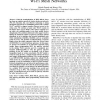Free Online Productivity Tools
i2Speak
i2Symbol
i2OCR
iTex2Img
iWeb2Print
iWeb2Shot
i2Type
iPdf2Split
iPdf2Merge
i2Bopomofo
i2Arabic
i2Style
i2Image
i2PDF
iLatex2Rtf
Sci2ools
113
Voted
JNW
2006
2006
Gateway Deployment optimization in Cellular Wi-Fi Mesh Networks
With the standardization of IEEE 802.11, there has been an explosive growth of wireless local area networks (WLAN). Recently, this cost effective technology is being developed aggressively for establishing metro-scale "cellular Wi-Fi" network to support seamless Internet access in the urban area. We envision a large scale WLAN system in the future where Access Points (APs) will be scattered over an entire city enabling people to use their mobile devices ubiquitously. The problem addressed in this paper involves finding the minimum number of gateways and their optimal placement so as to minimize the network installation costs while maintaining reliability, flexibility and an acceptable grade of service. The problem is modeled taking a network graph, where the nodes represents either the Access Points of IEEE 802.11 or wired backbone gateways. In this paper, we present two methods (1) an innovative approach using integer linear programming (ILP) for gateway selection in the cel...
Related Content
| Added | 13 Dec 2010 |
| Updated | 13 Dec 2010 |
| Type | Journal |
| Year | 2006 |
| Where | JNW |
| Authors | Rajesh Prasad, Hongyi Wu |
Comments (0)

